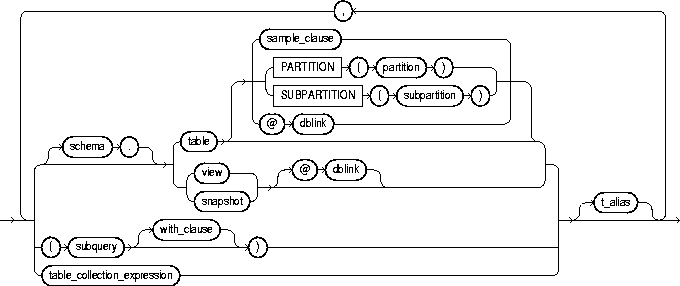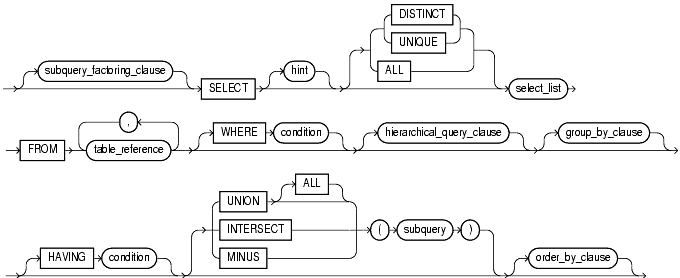The presence of HAVING turns a query into a grouped query even if there is no GROUP BY clause. This is the same as what happens when the query contains aggregate functions but no GROUP BY clause. All the selected rows are considered to form a single group, and the SELECT list and HAVING clause can only reference table columns from within aggregate functions. Such a query will emit a single row if the HAVING condition is true, zero rows if it is not true. The GROUP BY clause groups together rows in a table with non-distinct values for the expression in the GROUP BY clause.
For multiple rows in the source table with non-distinct values for expression, theGROUP BY clause produces a single combined row. GROUP BY is commonly used when aggregate functions are present in the SELECT list, or to eliminate redundancy in the output. Knowing how to use a SQLGROUP BY statement whenever you have aggregate functions is essential.
In most cases, when you need an aggregate function, you must add aGROUP BY clause in your query too. The first must contain a distinct first name of the employee and the second – the number of times this name is encountered in our database. The UNION operator computes the set union of the rows returned by the involved SELECT statements.
A row is in the set union of two result sets if it appears in at least one of the result sets. The two SELECT statements that represent the direct operands of the UNION must produce the same number of columns, and corresponding columns must be of compatible data types. Aggregate functions, if any are used, are computed across all rows making up each group, producing a separate value for each group. When a FILTER clause is present, only those rows matching it are included in the input to that aggregate function. There's an additional way to run aggregation over a table.
If a query contains table columns only inside aggregate functions, the GROUP BY clause can be omitted, and aggregation by an empty set of keys is assumed. The WHERE clause in MySQL is used with SELECT, INSERT, UPDATE, and DELETE queries to filter data from the table or relation. It describes a specific condition when retrieving records from a single table or multiple tables using the JOIN clause.
If the specified condition is satisfied, it returns the particular value from the table. The WHERE clause places conditions on the selected columns. Once the rows are divided into groups, the aggregate functions are applied in order to return just one value per group. It is better to identify each summary row by including the GROUP BY clause in the query resulst. All columns other than those listed in the GROUP BY clause must have an aggregate function applied to them. Function_nameFunction calls can appear in the FROM clause.
When the optional WITH ORDINALITY clause is added to the function call, a new column is appended after all the function's output columns with numbering for each row. The GROUP BY clause groups identical output values in the named columns. Every value expression in the output column that includes a table column must be named in it unless it is an argument to aggregate functions.
GROUP BY is used to apply aggregate functions to groups of rows defined by having identical values in specified columns. The GROUP BY clause is often used in SQL statements which retrieve numerical data. It is commonly used with SQL functions like COUNT, SUM, AVG, MAX and MIN and is used mainly to aggregate data. Data aggregation allows values from multiple rows to be grouped together to form a single row. The first table shows the marks scored by two students in a number of different subjects.
The second table shows the average marks of each student. The above query includes the GROUP BY DeptId clause, so you can include only DeptId in the SELECT clause. You need to use aggregate functions to include other columns in the SELECT clause, so COUNT is included because we want to count the number of employees in the same DeptId. The most important preconditions for using indexes for GROUP BY are that all GROUP BY columns reference attributes from the same index, and that the index stores its keys in order . ROLLUP is an extension of the GROUP BY clause that creates a group for each of the column expressions. Additionally, it "rolls up" those results in subtotals followed by a grand total.
Under the hood, the ROLLUP function moves from right to left decreasing the number of column expressions that it creates groups and aggregations on. Since the column order affects the ROLLUP output, it can also affect the number of rows returned in the result set. The value PRECEDING and value FOLLOWING cases are currently only allowed in ROWS mode. They indicate that the frame starts or ends with the row that many rows before or after the current row.
Value must be an integer expression not containing any variables, aggregate functions, or window functions. The value must not be null or negative; but it can be zero, which selects the current row itself. It is not permissible to include column names in a SELECT clause that are not referenced in the GROUP BY clause. The only column names that can be displayed, along with aggregate functions, must be listed in the GROUP BY clause. Since ENAME is not included in the GROUP BYclause, an error message results.
The Group by clause is often used to arrange identical duplicate data into groups with a select statement to group the result-set by one or more columns. This clause works with the select specific list of items, and we can use HAVING, and ORDER BY clauses. Group by clause always works with an aggregate function like MAX, MIN, SUM, AVG, COUNT. This syntax allows users to perform analysis that requires aggregation on multiple sets of columns in a single query. Complex grouping operations do not support grouping on expressions composed of input columns.
A functional dependency exists if the grouped columns are the primary key of the table containing the ungrouped column. GROUP BY will condense into a single row all selected rows that share the same values for the grouped expressions. In case of ambiguity, a GROUP BY name will be interpreted as an input-column name rather than an output column name. All the expressions in the SELECT, HAVING, and ORDER BY clauses must be calculated based on key expressions or on aggregate functions over non-key expressions .
In other words, each column selected from the table must be used either in a key expression or inside an aggregate function, but not both. You must use the aggregate functions such as COUNT(), MAX(), MIN(), SUM(), AVG(), etc., in the SELECT query. The result of the GROUP BY clause returns a single row for each value of the GROUP BY column. In the result set, the order of columns is the same as the order of their specification by the select expressions.
If a select expression returns multiple columns, they are ordered the same way they were ordered in the source relation or row type expression. Use theSQL GROUP BYClause is to consolidate like values into a single row. The group by returns a single row from one or more within the query having the same column values.
Its main purpose is this work alongside functions, such as SUM or COUNT, and provide a means to summarize values. The GROUP BY clause defines groups of output rows to which aggregate functions can be applied. If you don't use GROUP BY, either all or none of the output columns in the SELECT clause must use aggregate functions. If all of them use aggregate functions, all rows satisfying the WHERE clause or all rows produced by the FROM clause are treated as a single group for deriving the aggregates.
The ORDER BY clause specifies a column or expression as the sort criterion for the result set. If an ORDER BY clause is not present, the order of the results of a query is not defined. Column aliases from a FROM clause or SELECT list are allowed.
If a query contains aliases in the SELECT clause, those aliases override names in the corresponding FROM clause. The GROUP BY clause is a SQL command that is used to group rows that have the same values. Optionally it is used in conjunction with aggregate functions to produce summary reports from the database. The aggregate functions do not include rows that have null values in the columns involved in the calculations; that is, nulls are not handled as if they were zero.
Here, you can add the aggregate functions before the column names, and also a HAVING clause at the end of the statement to mention a condition. If specific tables are named in a locking clause, then only rows coming from those tables are locked; any other tables used in the SELECT are simply read as usual. A locking clause without a table list affects all tables used in the statement. If a locking clause is applied to a view or sub-query, it affects all tables used in the view or sub-query.
However, these clauses do not apply to WITH queries referenced by the primary query. If you want row locking to occur within a WITH query, specify a locking clause within the WITH query. If the WITH TOTALS modifier is specified, another row will be calculated.
This row will have key columns containing default values , and columns of aggregate functions with the values calculated across all the rows (the "total" values). This statement will return an error because you cannot use aggregate functions in a WHERE clause. WHERE is used with GROUP BY when you want to filter rows before grouping them. While the first query is not needed, I've used it to show what it will return. Otherwise, each column referenced in the SELECT list outside an aggregate function must be a grouping column and be referenced in this clause.
All rows output from the query that have all grouping column values equal, constitute a group. Adding a HAVING clause after your GROUP BY clause requires that you include any special conditions in both clauses. If the SELECT statement contains an expression, then it follows suit that the GROUP BY and HAVING clauses must contain matching expressions. It is similar in nature to the "GROUP BY with an EXCEPTION" sample from above.
In the next sample code block, we are now referencing the "Sales.SalesOrderHeader" table to return the total from the "TotalDue" column, but only for a particular year. The SUM() function returns the total value of all non-null values in a specified column. Since this is a mathematical process, it cannot be used on string values such as the CHAR, VARCHAR, and NVARCHAR data types. When used with a GROUP BY clause, the SUM() function will return the total for each category in the specified table. The SELECT statement used in the GROUP BY clause can only be used contain column names, aggregate functions, constants and expressions.
Non-commutative aggregate functions are sensitive to the order in which the rows are processed in the surrounding SELECT clause. To specify the order in which input rows are processed, you can add an ORDER BY clause within the function argument list. In conclusion, we didn't say that the SQLGROUP BY clause is one of the most powerful tools out there for no reason. It is preferred over the SELECT DISTINCT statement because it can be combined with aggregate functions. You can also use it with SQLORDER BY. However, you must make sure that you keep the right order when writing it.
Which Sql Query Must Have Must Have A Group By Clause But this technique is constantly being applied in queries, as it clarifies the analysis undertaken. If you are interested in learning about what else you can combine with the GROUP BY statement, you can learn all about the HAVING clause. This statement is used to group records having the same values. The GROUP BY statement is often used with the aggregate functions to group the results by one or more columns. Another difference is that these expressions can contain aggregate function calls, which are not allowed in a regular GROUP BY clause. They are allowed here because windowing occurs after grouping and aggregation.
The FROM clause specifies one or more source tables for the SELECT. If multiple sources are specified, the result is the Cartesian product of all the sources. But usually qualification conditions are added to restrict the returned rows to a small subset of the Cartesian product. The INTERSECT operator returns rows that are found in the result sets of both the left and right input queries. Unlike EXCEPT, the positioning of the input queries does not matter. The HAVING clause in a SELECT specifies a condition to apply within a group or aggregate.
In other words, HAVING filters rows after the aggregation of the GROUP BY clause has been applied. Since HAVING is evaluated after GROUP BY, it can only reference expressions constructed from grouping keys, aggregate expressions, and constants. (These are the same rules that apply to expressions in the SELECT clause of a GROUP BY query.) A HAVING clause must come after any GROUP BY clause and before any ORDER BY clause. Results from a HAVING clause represent groupings or aggregations of original rows, whereas results from a WHERE clause are individual original rows.
In this query, all rows in the EMPLOYEE table that have the same department codes are grouped together. The aggregate function AVG is calculated for the salary column in each group. The department code and the average departmental salary are displayed for each department. The only aggregate functions used in the select list are MIN() and MAX(), and all of them refer to the same column.
The column must be in the index and must immediately follow the columns in the GROUP BY. In some cases, MySQL is able to do much better than that and avoid creation of temporary tables by using index access. However, you can use the GROUP BY clause with CUBE, GROUPING SETS, and ROLLUP to return summary values for each group. Like most things in SQL/T-SQL, you can always pull your data from multiple tables. Performing this task while including a GROUP BY clause is no different than any other SELECT statement with a GROUP BY clause. The fact that you're pulling the data from two or more tables has no bearing on how this works.
In the sample below, we will be working in the AdventureWorks2014 once again as we join the "Person.Address" table with the "Person.BusinessEntityAddress" table. I have also restricted the sample code to return only the top 10 results for clarity sake in the result set. Another extension, or sub-clause, of the GROUP BY clause is the CUBE. The CUBE generates multiple grouping sets on your specified columns and aggregates them. In short, it creates unique groups for all possible combinations of the columns you specify.



























































